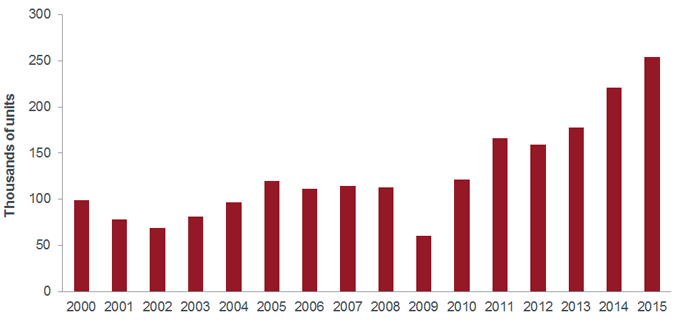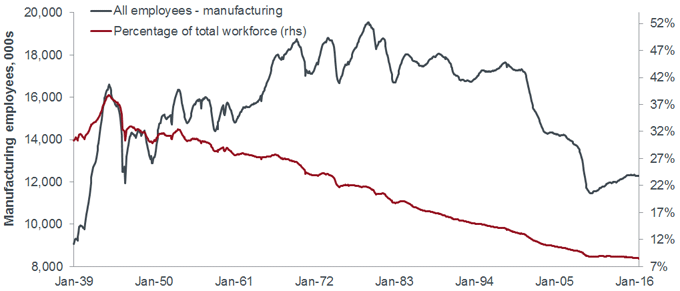Subscribe
Sign up for timely perspectives delivered to your inbox.
Over the past five years there has been an increasing number of bold pronouncements around what many are labelling the fourth industrial revolution. Wherever you look commentators are heralding the advancement of robotics as a real and present threat to our workforce. A study by Oxford Martin School estimates that 47% of jobs in the US are at risk of being automated in the next 20 years. The US government has projected 83% of jobs earning $20 per hour or less are vulnerable. The World Economic Forum sees 5m in net job losses by 2020.
These stark predictions are headline grabbing news – and who can blame a certain level of alarmism when we are seeing examples of technological advancement previously confined to Back to the Future movies.
This decade alone has introduced us to self driving cars clocking up thousands of miles without a scratch, industrial cooking machines churning out 400 burgers an hour and artificial intelligence (AI) programmes capable of besting the world’s top Go players. If the media rhetoric is to be believed we are not far off from having robot accountants, lawyers, carers and hairdressers – certain levels of human interaction then will become a thing of the distant past.
As robots have become cheaper while simultaneously becoming more capable, there has been an acceleration in shipments of industrial robots, particularly in manufacturing (see figure 1). These machines are already prominent in the automotive industry, working alongside their human comrades on assembly lines across the world.
Other firms, in the electronics and textile sectors for example, have relied on globalisation to suppress costs – Bank of America Merrill Lynch estimates corporations save 65% of their labour costs through offshore manufacturing. A shift to robotic workers would save 90%, and as the developing world starts facing their own headwinds of ageing demographics, rising wages and strengthening labour laws, we may see the shift in production methods spread.
Figure 1 – increasing supply of industrial robots
[caption id=”attachment_72404″ align=”alignnone” width=”680″] Source: International Federation of Robotics (IFR) Statistics, Henderson Global Investors, annual data, 2000-2015, as at June 2016[/caption]
Source: International Federation of Robotics (IFR) Statistics, Henderson Global Investors, annual data, 2000-2015, as at June 2016[/caption]
Some economists, such as the Strategic Fixed Income desk’s favourite secular stagnationist, Larry Summers, are already observing the shift. He ascribes the malaise in US manufacturing employment, which still significantly lags its pre-recession peak, to technology (see figure 2). As human workers become increasingly easier and cheaper to substitute with robots this trend of anaemic job creation and stagnant wage growth will continue to be felt.
Figure 2 – vanishing jobs in US manufacturing
[caption id=”attachment_72382″ align=”alignnone” width=”680″] Source: Federal Reserve Bank of St Louis, Henderson Global Investors, as at September 2016[/caption]
Source: Federal Reserve Bank of St Louis, Henderson Global Investors, as at September 2016[/caption]
To consign this problem to only that of the low skill, low income variety, is short-sighted. As robots have gained in their proficiency, speed, accuracy and efficiency, we have observed even faster developments in the field of AI – where advances tend to come with an air of ‘exponentiality’ not seen on the hardware side. Neural networking (sometimes referred to as ‘deep learning’) allows the creation of programmes that are able to learn and distinguish patterns in data, enabling them to make intelligent decisions and at a much faster rate than a human.
The implications of this are far reaching; Mckinsey estimates that 45% of activities people in the US are paid to do can be automated using current technology. Some see this as a gateway to higher productivity – if insurance brokers have to spend less time vetting applications, or doctors are able to automate the analysis of MRI scans, they may be able to dedicate more time to offering other services and time to their clients.
But will companies realising higher productivity try to translate this into higher growth or will they see it as an opportunity to reduce headcount and recoup their investments? The Summers school of thought would argue the latter but the impact of technology is not always so clear cut. Many proclaimed the death of the bank teller when the ATM was introduced but since the first ATM, the ranks of bank tellers have continued to swell. Fewer tellers were needed per branch but more branches opened due to this and allowed teller numbers to keep growing. The forecasted steady decline of these jobs now is attributable to the increasing popularity of online banking, more than 40 years since the introduction of the ATM.
There is a definite threat to existing jobs from automation (see figure 3), and it is not going unnoticed – Bank of England chief economist Andy Haldane recently cited the chances of accountants being replaced at 95%. But as with tellers, until the majority of what the role entails is automatable the effect of technology may be more complementary than destructive in the short term.
Figure 3 – likelihood of automation in a variety of roles

If this is truly the next industrial revolution, it is difficult to tell whether it will lead to widespread and permanent job losses or will give rise to new industry and new opportunities.
In 1900, 41% of the US labour force was employed in agriculture, by the early 2000’s this figure was less than 2%. Many of the jobs we are doing now could not have been fathomed at the start of the 20th century. We have already discussed shifting consumer behaviour in articles on the sharing economy and peak everything previously, and these changing tastes may dictate future job formation. We could see more jobs emerge in artisanal production, or customer facing roles amid an expansion of the experience economy. It seems premature to sound the alarm over the death of jobs at this point in time.
It is also increasingly hard to predict when these technologies will reach any sort of critical mass; expert predictions are as confident as they are perse. There are also numerous legal, regulatory, social, economic and other hurdles to overcome.
[caption id=”attachment_76057″ align=”alignright” width=”300″] Source: Shutterstock[/caption]
Source: Shutterstock[/caption]
We are already in the midst of a worldwide resistance to globalisation and immigration, seen as depressing wages and undermining domestic workers’ livelihoods. If machines are the new immigrants we may see pushback as workers under threat of technology revolt much like the luddites of the 1800’s in the UK. Legal challenges to Airbnb and Uber’s business practices are already being fought in many countries around the world.
Society too may take some time to catch up with the technology; despite the proficiency of robots, it will take time for people to adjust to the idea of getting a hair cut from a robot. Similarly the prospects of a cup of tea from a robot butler will have limited appeal to the baby boomers and older generations around the world. These are all unpredictable factors in the rollout of such disruptive technology that may cause delays.
Our assessment is that these shifts are structural, and ultimately deflationary in the near term. The seven years of recovery since the crisis have been characterised by stagnant growth and little or no inflation, which does not look to us as poised to change. Amid a lacklustre resurgence in manufacturing employment the labour force participation rate has been falling all around the developed world. Benefits of quantitative easing have accrued disproportionately to those with wealth as share prices and home values have risen rapidly. Of course it remains to be seen how far the new US President-elect’s policies of fiscal reflation and the focus on domestic jobs growth will set a trend to derail the robot revolution train given his other (protectionist) policies of lower trade and global openness, which could lower economic growth.
Technology for now seems to be poised to exacerbate this trend as robotics and AI cause further downward pressure in wages and as a result inflation. While we expect the effect to be broad based, we do see lower income jobs being affected sooner, and as this strata has the highest marginal propensity to consume it does not paint a promising picture for a consumer-led recovery.